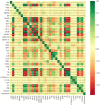Predictive Value of the Total Bilirubin and CA50 Screened Based on Machine Learning for Recurrence of Bladder Cancer Patients
- PMID: 38835478
- PMCID: PMC11149634
- DOI: 10.2147/CMAR.S457269
Predictive Value of the Total Bilirubin and CA50 Screened Based on Machine Learning for Recurrence of Bladder Cancer Patients
Abstract
Purpose: Recurrence is the main factor for poor prognosis of bladder cancer. Therefore, it is necessary to develop new biomarkers to predict the prognosis of bladder cancer. In this study, we used machine learning (ML) methods based on a variety of clinical variables to screen prognostic biomarkers of bladder cancer.
Patients and methods: A total of 345 bladder cancer patients were participated in this retrospective study and randomly divided into training and testing group. We used five supervised clustering ML algorithms: decision tree (DT), random forest (RF), adaptive boosting (AdaBoost), gradient boosting machine (GBM), and extreme gradient boosting (XGBoost) to obtained prediction information through 34 clinical parameters.
Results: By comparing five ML algorithms, we found that total bilirubin (TBIL) and CA50 had the best performance in predicting the recurrence of bladder cancer. In addition, the combined predictive performance of the two is superior to the performance of any single indicator prediction.
Conclusion: ML technology can evaluate the recurrence of bladder cancer. This study shows that the combination of TBIL and CA50 can improve the prognosis prediction of bladder cancer recurrence, which can help clinicians make decisions and develop personalized treatment strategies.
Keywords: biomarkers; bladder cancer; machine learning; recurrence; retrospective study.
© 2024 Zhang and Ma.
Conflict of interest statement
All of the authors declare that they have no conflicts of interest for this work.
Figures




Similar articles
-
Predicting the Recurrence of Ovarian Cancer Based on Machine Learning.Cancer Manag Res. 2024 Oct 9;16:1375-1387. doi: 10.2147/CMAR.S482837. eCollection 2024. Cancer Manag Res. 2024. PMID: 39399640 Free PMC article.
-
Machine learning-based models for the prediction of breast cancer recurrence risk.BMC Med Inform Decis Mak. 2023 Nov 29;23(1):276. doi: 10.1186/s12911-023-02377-z. BMC Med Inform Decis Mak. 2023. PMID: 38031071 Free PMC article.
-
Application of machine learning model in predicting the likelihood of blood transfusion after hip fracture surgery.Aging Clin Exp Res. 2023 Nov;35(11):2643-2656. doi: 10.1007/s40520-023-02550-4. Epub 2023 Sep 21. Aging Clin Exp Res. 2023. PMID: 37733228 Clinical Trial.
-
Prediction of Acute Respiratory Distress Syndrome in Traumatic Brain Injury Patients Based on Machine Learning Algorithms.Medicina (Kaunas). 2023 Jan 15;59(1):171. doi: 10.3390/medicina59010171. Medicina (Kaunas). 2023. PMID: 36676795 Free PMC article.
-
Interpretable machine learning model to predict surgical difficulty in laparoscopic resection for rectal cancer.Front Oncol. 2024 Feb 6;14:1337219. doi: 10.3389/fonc.2024.1337219. eCollection 2024. Front Oncol. 2024. PMID: 38380369 Free PMC article. Review.
Cited by
-
AI predicting recurrence in non-muscle-invasive bladder cancer: systematic review with study strengths and weaknesses.Front Oncol. 2025 Jan 7;14:1509362. doi: 10.3389/fonc.2024.1509362. eCollection 2024. Front Oncol. 2025. PMID: 39839785 Free PMC article.
References
LinkOut - more resources
Full Text Sources

